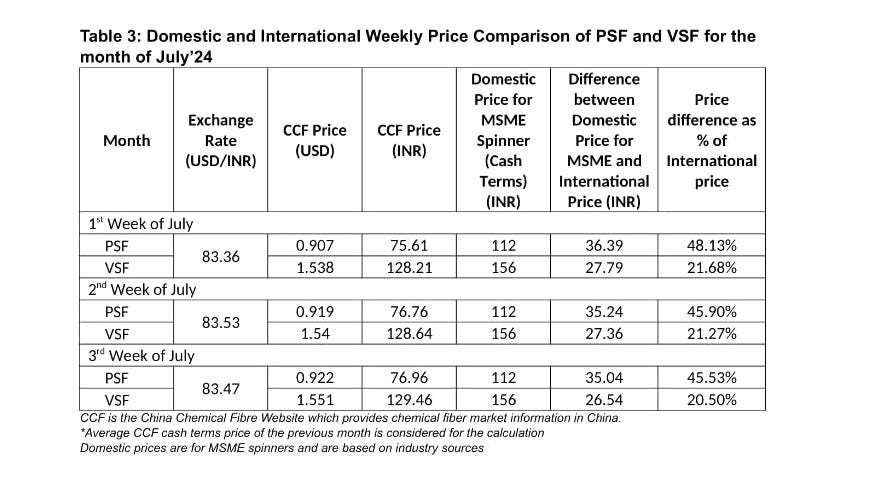Widening gap in domestic and international PSF, VSF fiber prices crushing Indian textile industry

The Indian textile industry is facing great pressure as the gap between domestic and international prices of key synthetic fibers, PSF (Polyester Staple Fiber) and VSF (Viscose Staple Fiber), continues to grow. As per data collated by Confederation of Indian Textile Industry (CITI), the disparity has grown during July 2024, raising concerns about the competitiveness of the domestic textile sector.
Key findings
Persistent price gap: The price difference between domestic PSF and VSF and their international counterparts (based on China’s CCF Group) has significantly increased in July 2024.
PSF price disparity: The domestic PSF price for MSME spinners was approximately 48.13 per cent higher than the international price in the first week of July. While this gap narrowed slightly in subsequent weeks, it remained substantial at around 45 per cent for the month.
VSF price disparity: The domestic VSF price also exhibited a considerable premium over the international price, ranging from 21.68 per cent to 20.50 per cent during July.
Impact on domestic textile industry
The widening price gap poses several challenges for the Indian textile industry.
Top most is reduced export competitiveness as higher domestic fiber prices make Indian textile products less competitive in the global market, potentially impacting export volumes and earnings.
Second is the increase in input costs. Domestic textile manufacturers face higher input costs, squeezing profit margins and eroding competitiveness.
It also is a potential for price increases as to offset higher input costs, textile producers may be compelled to raise product prices, which could further dampen demand.
Industry concerns
Industry experts and stakeholders have expressed growing concerns over the widening price disparity. They emphasize the need for urgent measures to address the issue and safeguard the interests of domestic textile manufacturers. Among the possible solutions are:
Raw material cost reduction: Government initiatives to reduce input costs for the textile industry, such as raw material subsidies or duty exemptions, could help mitigate the impact of higher fiber prices.
Currency appreciation: A stronger Indian rupee against the US dollar could narrow the price gap and improve export competitiveness.
Trade policies: Review of existing trade policies and negotiations for favorable trade agreements can create a level playing field for Indian textile exporters.
The Indian textile industry is a vital contributor to the economy, providing employment to millions. Addressing the widening price gap between domestic and international PSF and VSF is crucial to ensuring the sector's long-term sustainability and growth.
